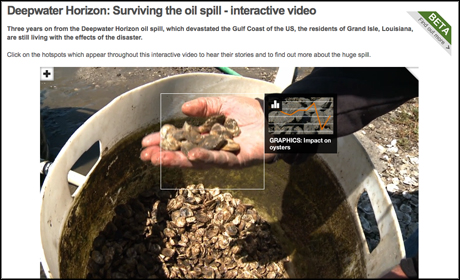
When it comes to the commercial side of the news business, the idea of making content clickable and interactive, offers up clear benefits – enabling users to click through to purchase items shown on the screen, for example.
But that is not the only way in which news outlets are using such technology to engage with their readers. The editorial side is also experimenting with this form of interactivity, in a way which helps to give users a very personalised experience, based on how much or how little they wish to interact.
There have been a number of key examples of this lately, such as the Wall Street Journal's video package on US healthcare, as well as a BBC News video in April revisiting the aftermath of the Deepwater Horizon oil spill.
At the time, BBC News used wireWAX to produce the interactive video, which features links to additional content or context, based on certain 'hotspots' in the footage, as shown below. BBC News described it at the time as "a trial format", and invited feedback from its readers on the approach.

The Guardian has also used wireWAX to create hotspots on products featured in a beauty video in December last year, enabling users to purchase the objects they see appear in what wireWAX calls "shoppable editorial". Clicking on 'hotspots' pauses the video and offers the viewer more detail on the product. They can return to the video by clicking back onto it.
The wireWAX platform launched in 2011, and as well as recently working with news outlets such as the BBC and the Guardian on more customised experiences, offers a free tool online which can be used to more simply add hotspots to people or objects in video.
"The tool is still fundamental to what we're trying to develop and we really want people to use that as much as possible," chief executive of wireWAX Steve Callanan told Journalism.co.uk.
"We want to be the first and only place people will come to to make their videos interactive and we want to make that whole process as seamless and as simple as possible."
But the customised editorial applications of the technology are a "growing" part of the business, co-founder Dan Garraway added.
Letting the viewer decide
A key part of a journalist's job is often to tell complex stories as clearly as possible, sometimes concisely, at other times in-depth. And the idea is that using technology like wireWAX, journalists can do both and let the viewer decide how much extra detail and context they want to access.
"Video online is short-form mostly," Garraway said, "and yet a lot of these stories are much more complex than the short-form allows.
"If you want to retain an audience for one or two minutes, that's great, but you've probably got content in there which is worth much more than that, perhaps five or 10 minutes.
"And wireWAX is something that allows you to embed that extra depth in the content. Keeping that linear video down to one or two minutes, but allowing those people who are interested in that particular subject, who are interested in particular aspects of that story, to go deeper when they want to. And that's really critical to the whole viewing experience. It's about when the viewer wants to interact with a particular piece of information."
"So it's a way of not just conveying a message in an interesting way but also understanding the needs of the viewers as well," Callanan added.It's a way of not just conveying a message in an interesting way but also understanding the needs of the viewers as wellSteve Callanan, wireWAX
The importance of planning interactivity
An interesting point to note is that during the BBC News documentary, for example, the interviewees at times speak directly to the viewer, highlighting opportunities to click for more detail. Garraway said that the idea of having interactivity part of the planning process early on, as opposed to it being more of an afterthought, is something which is "shifting tremendously"
"When we were first around on the scene, 'shoppability' was the thing that got people motivated, so they would slap it on afterwards."
But, he explained, "you've got enormous power when you start building it into the creative, calling out into the audience and telling someone who's been passively sitting back and watching content".
"When they've got an implement in their hand, like a mouse, or an iPad or the finger, they've got the ability to interact, to lean forward with that content. It's starting to become really interesting when people are using that potential."
Make clear 'calls to action'
Using such clear 'calls to action' where "appropriate" are important for encouraging interactivity, Garraway and Callanan said, particularly with audiences less used to interacting with video.
"Audiences have not traditionally had the ability to sit forward and touch the content, or click on an object or person they're interested in," Garraway explained. "So building it into the content and making it obvious is becoming more important and shooting with the interactivity in mind is obviously going to help that."
Callanan added that "it's an education process as well".People are so used to clicking play and leaning back and then absorbing content from beginning to end, that you almost have to really spell it out to people now that they can lean forward and interactSteve Callanan, wireWAX
"People are so used to clicking play and leaning back and then absorbing content from beginning to end, that you almost have to really spell it out to people now that they can lean forward and interact.
"I'm sure over time it will become less important to really slap it in people's faces, but at the moment the success of a video really depends on that call to action."
Engagement data is growing in importance
The tool offers all users a set of data on how people interact with their video, with personalised options available for those paying for a customised experience. For users of the free tool this includes "interaction over duration, geographic information, and what people are doing within the video experience," Garraway said.
The technology can record data as detailed as "mouse cursor position every second", Callanan added. The statistics show that on average, "87 per cent of people will click on at least one tag at least once".
"We are at a stage where people are fascinated by it, so interaction rates are going to be higher, but it does prove that people are willing to interact with video content," he said.
And Garraway added that "those metrics are actually becoming much more important", and for media organisations, are "influencing production in the future".
Free daily newsletter
If you like our news and feature articles, you can sign up to receive our free daily (Mon-Fri) email newsletter (mobile friendly).
Related articles
- How Reuters, Newsquest and BBC experiment with generative AI
- How AI can help journalists track MPs financial interests
- 38 mojo apps from BBC trainer Marc Blank-Settle
- Standing out in a crowded market: what makes a top news podcast?
- Tools for journalists: Missing Perspectives Directory, for connecting newsrooms with women









